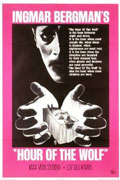
Sweden 1967
Directed by
Ingmar Bergman
89 minutes
Rated M
Reviewed by
Bernard Hemingway


The Hour Of The Wolf
Max von Sydow is a reclusive painter wracked by self-doubt and an obsessive love for his former mistress (Ingrid Thulin) in this dark story of madness and decadence, the first of three films made by Bergman in which von Sydow functions as the director’s alter ego (the other others are Shame (1969) and The Passion Of Anna (1970), and shot on the island of Fårö, where Bergman himself lived with Ullman, their child, Linn, being born during the filming of this.
Superbly photographed by Sven Nykvist, visually it is impressively adventurous with Bergman using various devices to suggest the mental disintegration of the von Sydow character in what evidently owes much to the classic horror film (the original script was called The Cannibals, with one character, Lindhorst, being made up to look like Bela Lugosi’s Dracula). Much is also made of Mozart’s "The Magic Flute" with, in one of the film’s most striking moments, Lindhorst presiding over a magical puppet theatre. In many ways also harking back to Bergman’s The Magician (1958), The Hour Of The Wolf is an outstanding use of tfilm to probe the boundary between imagination and reality.
Want something different?





